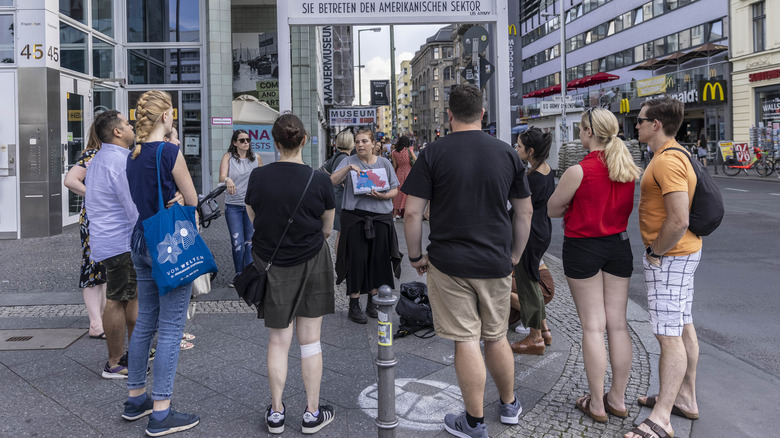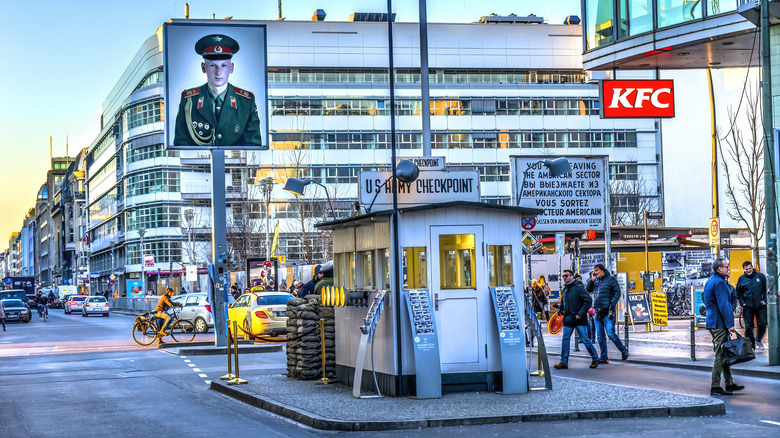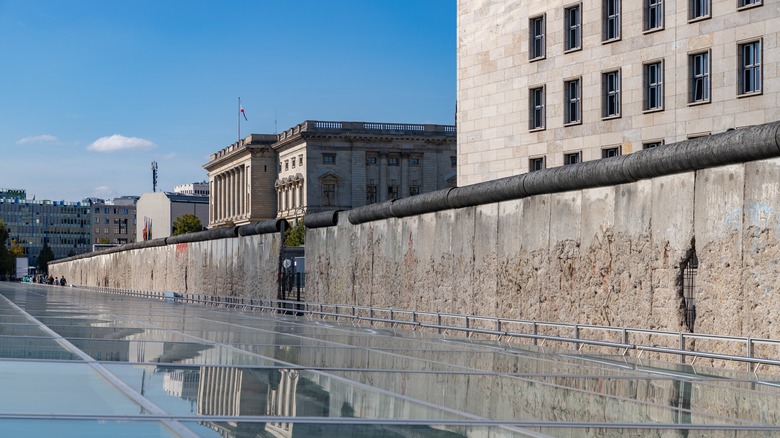The Obvious Tourist Trap In Europe People Still Flock To (And Where To Go Instead)
Berlin is one of the best European cities for history buffs. Since the fall of its much-hated wall in 1989, the German capital has moved into the 21st century as a vibrant and confident metropolis. The sleek skyscrapers on Potsdamer Platz and the striking glass viewing dome atop the Reichstag Building typify the buzzing modern city, while reminders of the past (both good and bad) are very much part of the landscape. The Brandenburg Gate is an inspiring symbol of unity, while Berlin's darker history is not forgotten: The Holocaust Memorial is a sobering reminder of atrocities during World War II, and fragments of the Berlin Wall are an echo from a once-divided city. The latter's most conspicuous landmark is also one of Berlin's biggest tourist traps: Checkpoint Charlie.
Constructed in 1961 to stop East German citizens from defecting to the more prosperous West, the Berlin Wall became Europe's most potent metaphor for the Cold War and the Iron Curtain. Encircling West Berlin, movement from one side of the city to the other was only possible via three checkpoints (although more were added later). The most famous of these, Checkpoint C, became known as Checkpoint Charlie. The friendly nickname belied the seriousness of the situation — defectors were killed trying to cross and, for a brief period in 1961, Soviet and American tanks faced each other across the divide. Despite its historical significance, Checkpoint Charlie now has a reputation as one of Berlin's tackiest landmarks. But why, and what are the alternatives?
Checkpoint Charlie today
Checkpoint Charlie's fame has increased over the years thanks to cameos in popular movies, such as "Octopussy" with Roger Moore as James Bond. It remained in use after the fall of the Berlin Wall in November 1989 and was finally closed the following year, then grew in status as one of the city's top tourist attractions. As of 2022, around 4 million people visited the landmark annually.
Although the original guard house was removed, a replica now stands on Friedrichstraße, near the famous sign warning that you are about to leave the American sector and the branch of KFC on the corner. The structure remains the focal point of Checkpoint Charlie, where tourists still flock to take selfies while leaning on the sandbags. You could once get your photo taken with actors playing military personnel, but that attraction came to a halt in 2019 after performers were exploiting the gig and charging visitors for pics and passport stamps.
On the same street is the Checkpoint Charlie Museum, several souvenir shops, a McDonald's, and a Mirror Maze. Since the turn of the century, it has received plenty of criticism from city officials and visitors alike. Thomas Flierl, Berlin's former minister of cultural affairs, once described it as a "tasteless mockery," per Spiegel International. More recently, disgruntled Tripadvisor users have called it an "unmitigated tourist trap" that is "underwhelming, hot and dirty" with "tacky souvenir shops." Another deplored snap-happy tourist mobs as "very disrespectful and distasteful."
Where to visit the Berlin Wall instead
The Berlin Wall once ran for 96 miles around the city, but very few traces of it remain today. As you wander the city, you may notice a row of cobblestones that mark where the wall once stood. However, there are several alternatives to touristy Checkpoint Charlie and its small remaining wall fragment, and a free walking tour is a great way to get a local perspective on this era of the city's history.
The longest remaining section of the Berlin Wall can be found at the hip East Side Gallery in Friedrichshain, which is also the longest open-air art gallery in the world. There is plenty to enjoy here: After the fall of the wall, over 100 international artists came to the city to paint the almost mile-long stretch of concrete with colorful murals and designs. Another well-preserved section can be found at a rather more somber monument: Bordering one flank of the Topography of Terror, a permanent exhibition detailing the horrors and persecution enacted by the Third Reich.
Another interesting place to visit is the Berlin Wall Memorial at Bernauer Straße. The whole street doubles as an open-air gallery commemorating how the Wall once brutally divided the citizens of Berlin, sometimes within the space of a block. This is where some famous 1961 photos were taken of East Germans leaping out of apartment windows into sheets held by neighbors and firemen on the West side. All the above are poignant reminders of a dark period in Berlin's story.


